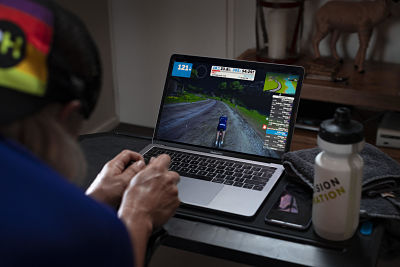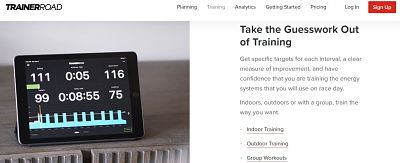Choosing the indoor training platform that's right for you will be influenced by factors such as personal preference, fitness levels, what you're training for, cost, and the ('Big Hairy Audacious') goals you're hoping to achieve this year.
Precision Fuel & Hydration's Sean O'Mahony is an experienced hand when it comes to working hard in his 'pain cave' and he's put all of those hours of indoor training to good use by reviewing the TrainerRoad platform...
The evolution of indoor cycling
Things have come a long, long way since indoor bike training involved getting your bike onto the rollers in your cold garage on wet rainy days. At least on the rollers the time went fast as you spent the majority of it trying to stay upright and not go careering off into the garage doors at 40 km/h.
It got really bad if you had to pull out the trainer, strap your back wheel in and then bang out a 90-minute indoor session. Usually there would be no real structure to the session, just a replacement ride for the one you had planned but binned because of the weather. After about 30 minutes of Zone 2 riding, the thought of another 60 minutes of ‘this’ usually meant there was only another 30 minutes of ‘this’.
Fast forward to 2021 and how things have changed.
Those early days of unstructured indoor rides have evolved into a massive industry. There's virtual rides with 25,000 others on any Saturday morning on Zwift. Live streaming video classes if you’re using a $3K+ Peloton bike. Or, endless hours of entertainment with the help of Spotify, YouTube or Netflix while you ride away on the rollers or the indoor trainer.

However, if you’re a committed cyclist or triathlete, you have to ask yourself what your time spent indoor training is really about. What’s the reason for not going out on your bike on open roads, enjoying the fresh air, and getting in the miles?
There are many valid reasons to not train outside: the weather, time constraints, you might live in a large urban environment.
But for me, it’s something that has crept up over the past four or five years. Distracted drivers.
Every time I go out on my road bike and look inside cars I notice more and more people using mobile devices. It's illegal to do so in most places but people are still tempted to do it.
Don’t get me wrong, riding outside is still one of the best things you can do but it’s not always enjoyable and it’s not always great training.
So indoor training is still here but it’s much more sophisticated and it really can have a positive impact on your training and overall fitness.
Why use TrainerRoad?
So, given the plethora of virtual and video-enhanced reality options available. Why am I still using a platform like TrainerRoad?
In a nutshell it’s about driving toward a goal with a focus. If your interest is being guided through your training by Beyoncé, then go for Peloton. If you want to ride with mates from all over the world in a virtual environment, then go for Zwift.
However, if you want to break 54 minutes in an upcoming 40km Time Trial and need to average 325 watts for the whole effort to do so, then TrainerRoad is your friend.
The FTP Test
After signing up, the first thing TrainerRoad asks you to do is take an FTP Test (Functional Threshold Power: analogous to your Lactate Threshold — the point at which your lactate production has levelled off). Basically, the test measures your current cycling ability by testing the power output you can hold for one hour.
Ultimately, the classic adage applies here, ‘you can’t improve what you don’t measure’.
In a nutshell, that statement defines what TrainerRoad is really all about. Measure your FTP, build your training sessions around your current level, do the work, then come back in 6 weeks, and repeat until you achieve your goal.
PH's Supply Chain and Logistics Manager Sam is a relative 'newbie' in indoor cycling terms after he ditched his road bike in favour of an indoor trainer when the British weather inevitably turned. He's shared his experience of using TrainerRoad and the FTP Test:
I ran my first FTP ramp test and immediately clicked - the team at Trainer Road clearly have a great sense of humour (if somewhat sadistic at times!) - their commentary pops up on the screen to guide you through the ramp test, egging you on to push just that little bit further. This commentary is also available in a good selection of the hundreds of training rides you can pick and choose from.
As someone who's more comfortable in a forecasting spreadsheet than planning how to reach an FTP to be proud of, the built-in plans are fantastic.
I do enjoy a good podcast or Netflix series during my rides, so being able to minimise TR to just a thin bar at the bottom of the screen on my laptop without missing any vital info is perfect.
On paper I really thought I would be a Zwift fanatic, but for me, Trainer Road has helped me maintain focus and progress as a cyclist. Well worth a try!
Structured Training Plans
Once you’ve completed your FTP Test, TrainerRoad makes it really simple to start a training plan. Head to the Training Plan builder section of their website, choose the right plan for your goal (if there isn’t one that fits your needs I would be very surprised), sign up for it and off you go.

PH's Customer Service Manager James is an experienced age-group triathlete who's routinely smashing out the miles in his 'pain cave' and he gave us this verdict on TrainerRoad's plans..
We all know Zwift provides a plethora of visual distraction and social interaction, which no doubt makes jumping on the indoor trainer far more appetising and has unlocked a new world (literally) to many a pedal-pusher.
But when it comes to actually training towards a specific goal without a coach, I honestly haven’t seen a better platform than TrainerRoad to walk someone hand-in-hand towards a goal.
The ability to build a very specific plan is virtually what you’d get from a lot of very good coaches, and the calendar provides a clear outline of what you’ve got to do and what’s to come as you progress towards your goal.
The emphasis is placed heavily on testing, building, testing again and measuring as much as possible. Which for a lot of athletes may be a new experience but will definitely leave them feeling like a more accountable and confident athlete.
Calendar
We are huge fans of getting training sessions hard-coded into your calendar to help keep yourself accountable. This is a simple and very effective method to ensure adherence to the plan. The single most important component of any training plan is consistency.
If you get an alert ahead of time to prepare yourself (and your family if necessary) then you're much more likely to complete the session. TrainerRoad make this simple as all your sessions will be imported into a calendar to which you can subscribe via Training Peaks, GCal, Outlook, etc.
Podcast
As a bonus and this fourth component really is the icing on the cake...
TrainerRoad has a fantastic podcast where they talk about everything training (not just TrainerRoad).
So as you’re banging out another session in your pain cave, it’s an ideal way to stay up-to-date with stories of people like you who are trying to achieve a goal while managing the stresses of modern life.
In my opinion, the TrainerRoad approach is absolutely ideal for any athlete with a pre-defined goal. Now is the time to assign yourself a goal. And if you do, TrainerRoad could be an excellent platform to help you achieve a positive outcome.
